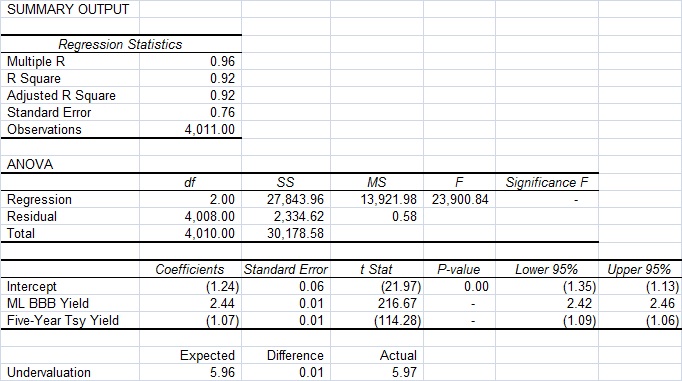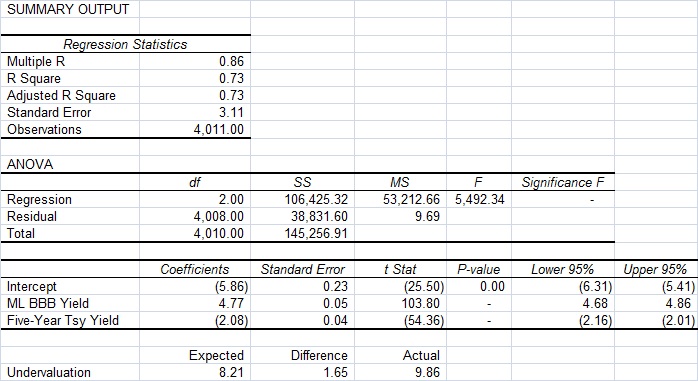Near this time in 2012, I wrote a piece called “Expensive High Yield.”? In it I argued that higher quality high yield bonds were overvalued, but that CCCs might still have some play.
Here was my conclusion:
Whether I look at the Merrill High Yield Master 2, BBs, or Bs, junk bonds look expensive.? CCCs look a little cheap.? The yields on the High Yield Master 2 look about 0.8% expensive in terms of yield (that?s the residual in the above graph).? I will be lightening credit bond/loan positions in the near term.? Of course this is just my opinion, so do your own due diligence.
And, please realize that movements in the stock market may swamp my observations.? If the stock market runs, high yield can run further? but there will be an eventual snap-back.?? The bond market is bigger than the stock market, eventually the stock market reacts to bond market realities.
So what happened?? The stock market ran, and all corporate bonds tightened, Investment Grade and Junk.? Yield seeking continued, as people look for ways to earn 4% without undue risk.
But tonight I want to take a slightly different approach than last year, daisy-chaining the overvaluations in the corporate bond market.? I’m using the same data as last time — the indexes are the Merrill Lynch Corporate Yield Indexes as published at FRED of the St. Louis Fed.
The baseline for corporates are the few large AAA issuers.? The first check is whether AAAs are overvalued versus history.? Here are my regression results:
Okay, what this shows is that the concept of spread over Treasuries even at the AAA level is not valid.? The odds that the true coefficient versus the 5-year Treasury is one is minuscule.
This says that spreads on AAA bonds should widen when Treasury rates are low.? It also indicates that the simple model expects AAA yields to be 0.30% higher than they are now.
Perhaps that stems from the actions of the Fed, which they are now perhaps beginning to regret.? There are real costs when you force people to take more risk to get income.
My next step is to consider BBB bond yields as a function of five-year Treasury yields, and the Merrill Lynch AAA bond index yield.
The current environment shows a great deal of desire for yield.? BBB bonds are 0.87% lower than they should be relative to history.? If I used what the earlier model said the AAA yield would be? this would look worse by maybe 0.50%.
Perhaps that reflects the effects of QE as well, but with more vigor, as higher yields get competed down more.
That brings me to the next link in the chain, where I compare Merrill High-Yield Master II versus their BBB index.
Now, relative to where BBB bonds are currently priced, junk bonds are fairly priced versus history.
I would still argue the BBBs are too tight versus history, which means the same for the High-Yield Master.
That brings me to look at the yields on the CCCs.? I played this on two ways.? First, like the way with the high yield master:
In this case, it looks like CCC bonds are still relatively cheap to BBBs.? Let’s try a slightly different specification, because CCC bonds have equity-like aspects far more than BBB bonds.
So why not add in the high yield master?
It doesn’t have much effect on the ultimate result.? CCC bonds still look relatively cheap.? Do I trust this result?? No.
All that said, all of this points to a kind of exponential effect with respect to yields on various bonds with credit ratings.? Bond categories are highly correlated to those that are near them, but often negatively correlated to those a step or two beyond, when regressors are considered as a group.
Summary
All of the corporate bond market is expensive relative to history, perhaps excluding CCC bonds.? That doesn’t mean it can’t get more expensive, particularly if stocks continue to move upward.?? But this won’t last for more than two years; the signs of speculation are here, and that should make us cautious.
As a result, I am investing my bond strategy cautiously now.? What little yield I get comes from emerging market sovereigns.? Credit risk from corporates is small.






The problem with this analysis is that it assumes a constant relationship over the past 15 years (I am assuming 15yrs of history based on the original article).
US Treasury debt is no longer market priced – it has not been market priced since late 2007.
One might argue it was a grey area ever since Bernanke left the classroom, but starting with the collapse of Bear Stearns (an isolated, one time event we were told!!!) – the Treasury market ceased to function.
The Fed is not a market (it would be but one player in a true market). The primary dealer banks (which are mostly still insolvent, dependent on Fed subsidies for their existence) might be legally separate entities, but for practical economic purposes they are mere extensions of the NY Fed and FOMC policy.
As many pundits have pointed out, the Fed has monetized almost all net new Treasury issuance. Add in the Treasuries that the Fed is essentially parking on money center bank balance sheets – and the Fed is most, if not all, of the US treasury “market”.
Sorry, but you cannot make any valid comparison between a kinda-sorta free market of pre-2007, and the clown show of prices set by FOMC decree.
A free market would never bid yields below CPI for the 5yr note, never mind the entire yield curve. The US Treasury market is an academic fantasy, not a market at all.
Your conclusion may prove to be right — for the wrong reasons. When some kid starts yelling about how the emperor has no clothes (something we all know, but choose not to see because adults succumb to politics / fear of the King’s wrath) — the FOMC’s lies will collapse and Treasury debt will revert to a real market.
That doesn’t mean that bonds are “overpriced” — which is a free market concept with no meaning right now.
As long as prices and yields are decided by a political committee (that is what the FOMC is), historical relationships and economic fundamentals “don’t matter”. It is not a free market.
Hi David
Another interesting article. Thanks
I agree the current spreads are tight so what choices do we have ? My view is that BB bonds still provide the best yield for risk and price at the moment. Even if they are historically “overpriced” they are the least worst alternative.
I am also starting to look at Preferred Funds like PFF. I would appreciate your thoughts.
Thanks
x888s43 — I would also like to hear more David’s thoughts on specific higher yield (lower credit rated) securities.
My two cents is that PFF is yet another backdoor Fed vehicle to finance banks. If you look at the ETFs top holdings (GM, GMAC, and big banks) … it is a who’s who of government bailout firms.
The yield on PFF is not markedly different from that of JNK (PFF is slightly lower). I am not claiming they are one in the same, but I am claiming they are very similar credit risks.
PFF yields slightly less — reflecting the implied credit guarantee of the Fed and Treasury to politically connected firms like GM, GMAC, Wells Fargo, Barclays, Citigroup, etc.
What happens when politicians are forced to deal with their lack of money? The debt ceiling is another political beast, but it is there to impose some fiscal discipline. The bigger issue is the total size of the national debts (plural) to GDP — and whether the debt is money good.
As politicians are forced to decide which debts to honor in full, and which ones to honor fractionally (or perhaps not at all) — I have to wonder how Tim Geithner’s unlimited backing of failed banks is going to line up with health care and social security spending?
How is it going to line up with long term care for veterans injured in combat? How is it going to line up with education spending (whether that education goes to union workers or actual education costs)?
Life is about making good choices, and “all the above” is not really a choice. It is a cop-out.
I don’t know when the US government will be forced to make actual decisions — but with debt exceeding 90% of GDP, the time horizon moved from “someday” to “soon”.
Securities (and entities) that depend on federal government largess seem to have a lot more risk than the last few decades of history would suggest.
That is why (IMHO) all the government subsidized entities — muni bonds, PFF / banks, student loan debt, college backed debt, etc — is being priced very similarly.
They are being priced pretty close to junk bonds — because the cash flow isn’t there to honor all debts. Handicapping which political promise will be broken first is nearly impossible.
Some sell side strategists will voice opinions of course — but given the forecasting track record of political leaders (ie the people voting on which promises to breach), investors are playing Russian roulette with all these securities.
PFF’s performance is going to be tied to the winds of politics. Does the added yield compensate for the added uncertainty?